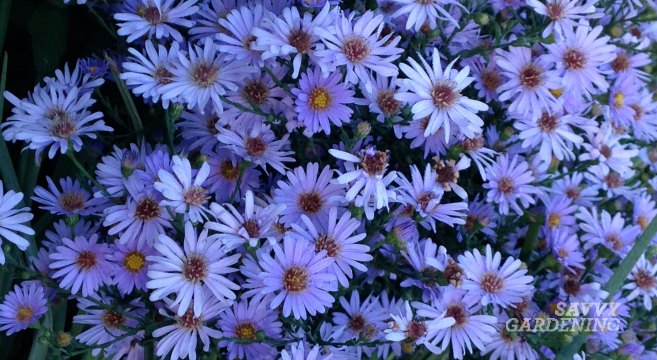This post may contain affiliate links. If you make a purchase through links on our site, we may earn a commission.
Asters are hands-down my favorite fall-blooming plants. These colorful, pest-resistant, and late-flowering perennials are perfect for gardens in areas where winter temperatures dip as low as -30 degrees F. There are about ninety species of aster native to North America, many with dozens of named cultivars, varieties, and subspecies. They range from one to four feet in height and vary in color from pink and purple, to red, white, lavender, and blue. The choices are dizzying!
Most native asters used to be in the genus Aster but are now in the genus Symphoyotrichum. From here on out – or at least until they change it again – the genus Aster only refers to Old World species of asters. Regardless of the nomenclature change (and the spelling and pronunciation problems many gardeners are facing because of it), asters are one exceptional group of plants. Not only are they a good-looking and easy-natured group, they lay out the welcome mat for beneficial insects and pollinators.
Favorite types of asters
Though I love almost all types of asters, these late-season perennials have some real stand-out varieties to choose from. In my garden, my aster plants are in bloom from late August through late September, but I found that if I trim the plants back halfway in early June, I can delay the blooming by a few weeks and have asters in bloom until late October or early November in my Pennsylvania garden.
If you’d like to add some exceptional varieties of this fall-blooming perennial to your garden, here are some of my favorite types of asters.
Aster ‘Alma Potchke’
One of the best asters on the market, ‘Alma Potchke’ stands over 3 feet tall and produces hot pink blooms with yellow centers. The flowers are very prolific, but the stems are a bit weaker than some other varieties, so I’d suggest staking this one.

Aster ‘Purple Dome’
The bright purple flowers of this variety are borne prolifically on short, stocky stems. Topping out at just 18 inches tall, ‘Purple Dome’ looks beautiful with ‘Fireworks’ golden rod and ‘Moerheim’s Beauty’ Helen’s flower. Together, they make a total knock-out combination.

Aster ‘Kickin’ Purple’
This compact variety of asters is suited to smaller gardens and backyards. Standing just 1 to 2 feet tall, the plant is absolutely smothered with bright purple flowers. ‘Kickin’ Purple’ earned its name honestly!
Aster ‘Lady in Black’
These 2 to 3 foot tall plants are covered with small pink-red blooms in the autumn. One of my favorite late-blooming perennials, ‘Lady in Black’ doesn’t require staking and fills the garden with butterflies and native bees.
Aster ‘Blue Lagoon’
This dwarf aster is late blooming and the perfect fit for small gardens. ‘Blue Lagoon’ produces purple-blue flowers with yellow centers and stands just 12 to 18 inches tall. I love it with white Japanese anemones and other late-blooming perennials.

Caring for perennial asters
Perennial asters require very little in terms of their care. Site them in locations with a minimum of 6 hours of full sun and be sure they receive regular irrigation until they’re established. After that, the plants are quite drought tolerant and low maintenance. To delay blooming even further, pinch back the end of every stem by 1/3 to 1/2 in mid to late June. This causes the branches to fork and produce more flowers. It also encourages a more compact, denser growth habit.
Since these perennials produce such wonderful late-season blooms, they really do deserve a home in your garden.
For more on great perennials for your landscape check out the following posts:
- Late-season flowering perennials
- Late-season flowering perennials
- 10 of the longest flowering perennials for your garden
- Shade-loving perennials: 15 beautiful choices
Which asters are already at home in your garden? We’d love to hear about them in the comment section below.
Pin it!




I have been frustrated by asters labeled as bee friendly, which turn out not so. When the blooms are doubled, it seems insects don’t have access to or are not attracted to stamens. Or, maybe it’s that the varieties are bred to be sterile? Thanks for these recommendations.
Excellent observation. In general, plant varieties with double flowers are not bee-friendly as the nectaries are buried beneath layers of petals or the varieties are sterile. So, if you want asters that are able to support bees, choose single flowers. And perennial species tend to be more pollinator-friendly than annual asters. Thanks for thinking of the bees! 🙂